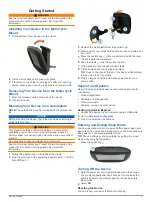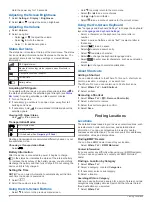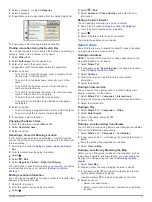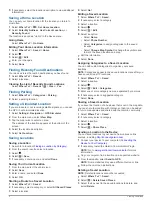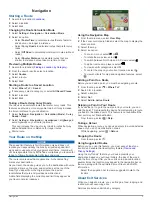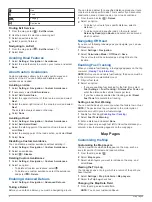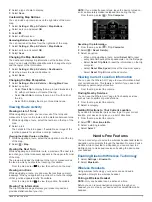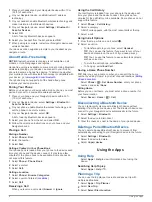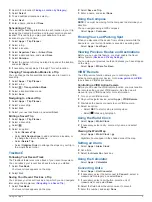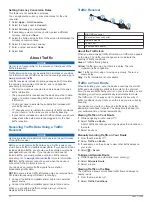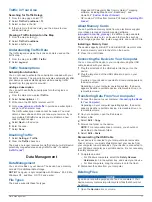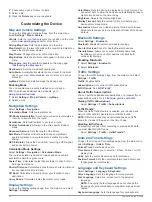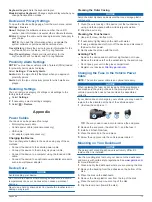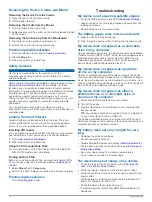
Traffic in Your Area
Searching for Traffic Delays
1
From the map page, select
.
2
Select
Traffic Conditions
> .
3
Select an item in the list.
4
If there is more than one delay, use the arrows to view
additional delays.
Viewing a Traffic Incident on the Map
1
From the map, select
.
2
Select
Traffic Conditions
.
3
Select a traffic icon.
Understanding Traffic Data
The traffic legend explains the icons and colors used on the
traffic map.
1
From the map, select >
Traffic
.
2
Select
Legend
.
Traffic Subscriptions
Subscription Activation
You do not need to activate the subscription included with your
FM traffic receiver. The subscription activates automatically after
your device acquires satellite signals while receiving traffic
signals from the pay service provider.
Adding a Subscription
You can purchase traffic subscriptions for other regions or
countries.
1
From the main menu, select
Traffic
.
2
Select
Subscriptions
> .
3
Write down the FM traffic receiver unit ID.
4
Go to
to purchase a subscription
and get a 25-character code.
The traffic subscription code cannot be reused. You must
obtain a new code each time you renew your service. If you
own multiple FM traffic receivers, you must obtain a new
code for each receiver.
5
Select
Next
on the device.
6
Enter the code.
7
Select
Done
.
Disabling Traffic
1
Select
Settings
>
Traffic
.
2
Clear the
Traffic
check box.
The device no longer receives live traffic data, but will still avoid
potentially congested areas using trafficTrends
™
, if enabled
(
).
Data Management
Data Management
You can store files on your device. The device has a memory
card slot for additional data storage.
NOTE:
The device is not compatible with Windows
®
95, 98, Me,
Windows NT
®
, and Mac
®
OS 10.3 and earlier.
File Types
The device supports these file types.
• Maps and GPX waypoint files from myGarmin
™
mapping
software, including MapSource
®
, BaseCamp
™
, and
HomePort
™
• GPI custom POI files from Garmin POI Loader (
About Memory Cards
You can purchase memory cards from an electronics supplier,
or purchase pre-loaded Garmin mapping software
(
). In addition to map and data
storage, the memory card can be used to store files such as
maps, images, geocaches, routes, waypoints, and custom POIs.
Installing a Memory Card
The device supports microSD
™
and microSDHC memory cards.
1
Insert a memory card into the slot on the device.
2
Press it in until it clicks.
Connecting the Device to Your Computer
You can connect the device to your computer using the USB
cable included with your device.
1
Plug the small end of the USB cable into the port on the
device.
2
Plug the larger end of the USB cable into a port on your
computer.
A picture of your device connected to a computer appears on
the device screen.
Depending on your computer operating system, the device
appears as either a portable device, a removable drive, or a
removable volume.
Transferring Data From Your Computer
1
Connect the device to your computer (
).
Depending on your computer operating system, the device
appears as either a portable device, a removable drive, or a
removable volume.
2
On your computer, open the file browser.
3
Select a file.
4
Select
Edit
>
Copy
.
5
Browse to a folder on the device.
NOTE:
For a removable drive or volume, you should not
place files in the Garmin folder.
6
Select
Edit
>
Paste
.
Disconnecting the USB Cable
If your device is connected to your computer as a removable
drive or volume, you must safely disconnect your device from
your computer to avoid data loss. If your device is connected to
your Windows computer as a portable device, it is not necessary
to safely disconnect.
1
Complete an action:
• For Windows computers, select the
Safely Remove
Hardware
icon in the system tray, and select your device.
• For Mac computers, drag the volume icon to the trash.
2
Disconnect the cable from your computer.
Deleting Files
NOTICE
If you do not know the purpose of a file, do not delete it. Your
device memory contains important system files that should not
be deleted.
1
Open the
Garmin
drive or volume.
Data Management
11



